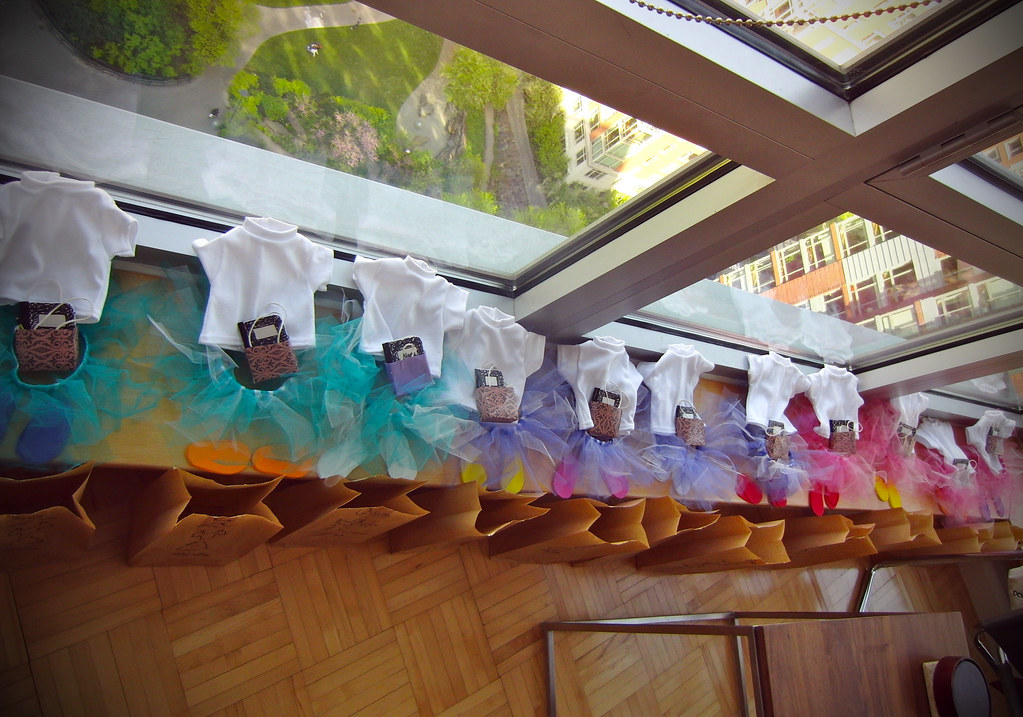Our daughter, Q, had her 7th birthday last Sunday. My lovely wife has, as usual, been working for weeks on parts for Q’s party, the theme of which this year is designing for dolls. The whole idea can be described as Extremely Girly, but all of us like to make and to encourage the making of things, even if that means inviting 8 girls over to make their 18"* dolls pretty.
And how they did prettify those dolls. We’ve found a guest list of around 10 or so manageable in our apartment, so we set and hit that target this year, too. My wife knows the fabric stores just south of Canal Street well, and she came back from one of them with a roll of elastic that she cut and sewed into rings. To those she tied strips of colored tulle (also bought in bulk at the fabric store and disassembled) to make great doll tutus in a variety of colors. She also ordered doll-sized plain-white t-shirts for each girl to decorate during the party with fabric markers and an iron-on flower positioned as each girl liked. My wife had their feet covered as well. Q asked each girl ahead of time about her footwear-color preference and made a list with the results, which we then used to cut craft-foam soles for sandals. During the party, the girls chose ribbon to loop over their doll’s feet, which my wife then hot-glued together with the foam. The girls could then affix sequins and other shiny ornaments to the ribbon to complete the bespoke shoes. Even the parting goody bags were for the dolls — little wrapping-paper shopping bags containing a miniature composition notebook and a toothpick pencil, all handmade and clever. Overall, the craftwork was basically insane in its tediousness, but the results (pictured above and below) truly amazed.
 |
| Note: To grasp scale, the pencils are made from toothpicks |
At this age, the parties tend to be drop-off, and we kept the girls busy. The Boy, who expertly helped make the tiny pencils, fled the house early to a series of friends’ places, and he made me swear that No Girls Be Allowed In His Room.** Q more or less floated to the door when the bell rang, and the just-arrived guest then accompanied her to the door at the next bell, building the greeting with each newcomer. Once they had all come, dolls in the crooks of their elbows or fastened into little carriers with cutouts for their faces, the girls set to work decorating their shirts. My wife set up a hot-glue station on the far side of the room, which the girls took turns visiting while they waited for me to iron flowers onto their doll shirts. I kept the snacks and drinks fresh; Q did the same with the overall atmosphere. After the girls had made shirts and sandals and dressed their dolls in the new tutus, we had them all sit and eat. Originally we thought we’d order pizza (like nearly every kid party ever), but we offered the group a choice between that and dumplings, and it was no contest. And, man, can 9 seven-year-old girls put away the dumplings.
Then it was cake time. My wife now has a well-earned reputation, inside our house and out, for great birthday cakes. This year she made a two-layer lemon number with sky-blue frosting and purple-sugar accents. The only decoration (besides Q’s name and the requisite wish piped at the bottom) was a tiny feathered gown and handbag hung on a miniature clothesline. I know my wife thought it fell short of her best efforts, but I thought it was, like her, elegant and beautiful.
We asked the moms to come back a little before the party’s end for a doll fashion show.*** Once the audience was in place, we lined the girls up in our apartment’s hallway and put on some music. They took turns looping through the living room, showing off the clothes they just made as the adults clapped. The girls themselves wore big smiles of fun and a little embarrassment, but most of them wanted to do it again. Q had a great time, and we hope that everyone else did, too.
A. A. Milne’s poem “The End” from his collection Now We Are Six goes:
When I was One,
I had just begun.
When I was Two,
I was nearly new.
When I was Three,
I was hardly me.
When I was Four,
I was not much more.
When I was Five,
I was just alive.
But now I am six, I’m as clever as clever.
So I think I'll be six now for ever and ever.
This poem is one of Q’s favorites, and mine too, but for different reasons. She likes the short, smart rhymes and the little story it tells that we can easily add on to as we walk to school or wonder about the bus.**** I like that, too, but also how Milne captures the way kids sometimes treat time as just another choice to be made while he himself participates in that choice. Milne calls the poem “The End” and hands it to his reader on the way out of the book, and in doing so gives the last line a type of truth, though Christopher Robin eventually left the nursery and the Hundred-Acre Wood and, ultimately, this earth. In a sense, then, Milne also wants his son to be six now for ever and ever. I understand the impulse.
That evening, after Q and The Boy had come down enough from the day to give in to the night, the house gets still. It’s been raining solid and hard all day, the storm knocking on all the windows at once, wanting in. Quiet comes on, at first before it’s noticed, like a brush of breeze that stands out once the air goes calm. These are times when it’s hard to believe that quiet is like cold — an absence of something rather than a thing in itself. Outside, the Hudson River slows and smooths, then stops altogether, the ferries frozen at the tip of their wakes like brushstrokes. See a dog caught mid-bark just off the park, its owner in a swipe at his phone; the trees bent by the wind stay bent. I can take this world and turn it, can find Q in every corner. At her desk in her room in a book, then making lists with a pencil that needs sharpening. Out front with her hands deep in the sand, looking to see if I’m looking at her. On line for Italian ice from the man on Chambers Street who knows her well now, both of them wondering which flavor she wants this time. Hanging upside down on a playground bar and showing someone how it’s done. Always everywhere there’s that face of hers, the one where she half-closes her eyes and half-smiles, meaning she’s seen through a joke or an attempt at a tease.
Q, asleep, exhaled. The Hudson wrinkled itself back up, and the ferries aimed for their slips. I thought I heard the dog finish its bark, but it was hard to tell over the rain.
Happy birthday, Q. Now you are seven, still as clever as clever. We will love you forever and ever.
_________________________
*I’m deliberately being general here. American Girl used to own the 18"-doll category pretty much outright — every girl but Q brought one of these to the party — but some compelling newcomers have recently moved in on AG’s territory. Q (now) has two Journey Girls dolls, which do look slightly different than American Girls, only noticeably so when the two get put side-by-side and a person really looks. Other differences exist too, but they trigger thorny questions about class and feelings of inadequacy that can extend into adulthood, so I’ll stop right about here.↩
****We’ve decided that it should now go: “When I was six / I learned some tricks. / But now that I’m seven, I’m as clever as clever…” Now you try.↩





